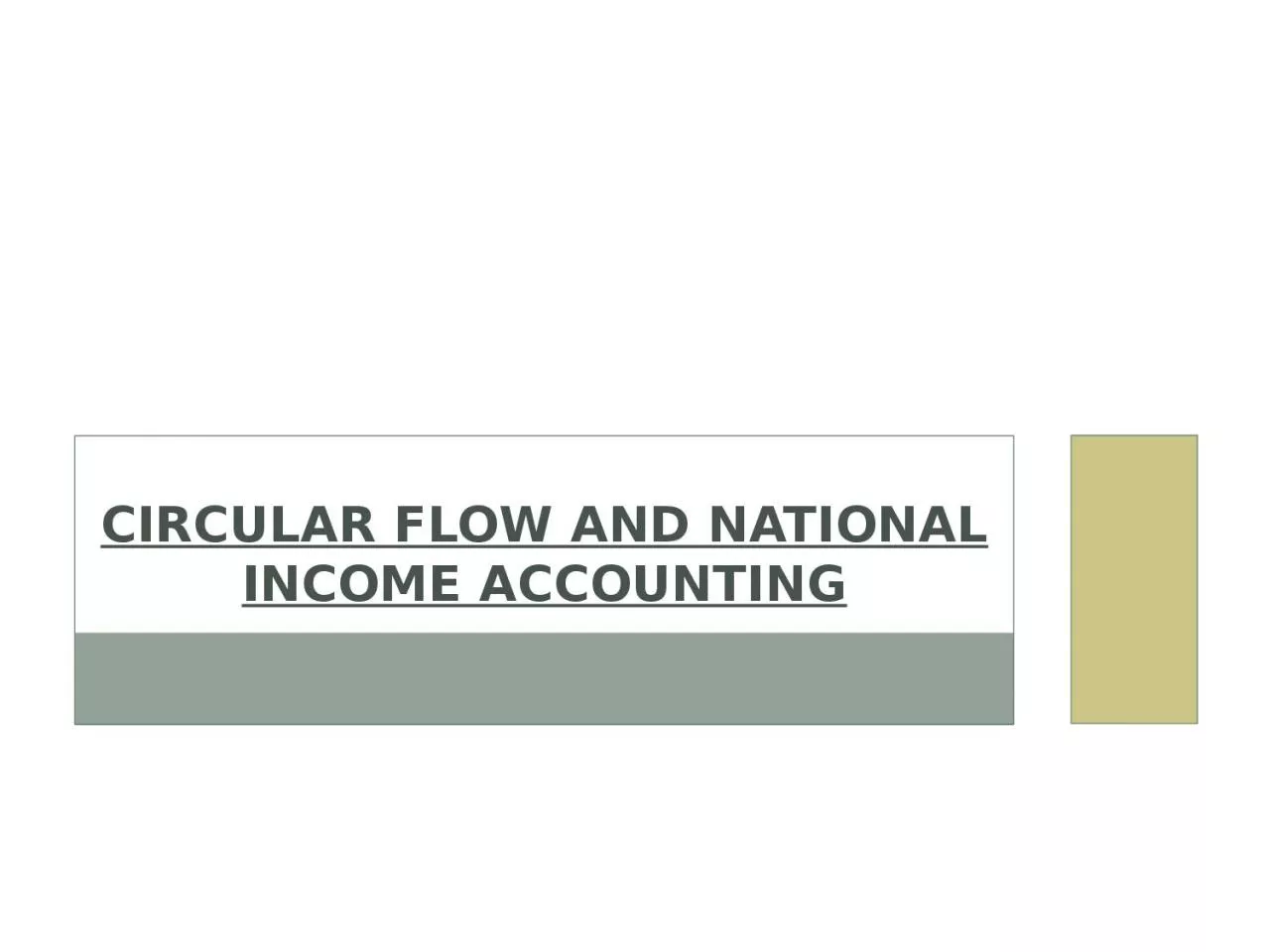

Gross Domestic Product GDP GDP is the market value of all final goods and services produces within a country in a given period of time Y C I G NX Y GDP C Consumption I Investment ID: 1029624
Download Presentation The PPT/PDF document "Circular Flow and National Income Accoun..." is the property of its rightful owner. Permission is granted to download and print the materials on this web site for personal, non-commercial use only, and to display it on your personal computer provided you do not modify the materials and that you retain all copyright notices contained in the materials. By downloading content from our website, you accept the terms of this agreement.
1. Circular Flow and National Income Accounting
2. Gross Domestic Product (GDP)“GDP is the market value of all final goods and services produces within a country in a given period of time”Y = C + I + G + NXY = GDPC – ConsumptionI – InvestmentG – Government PurchasesNX – Net Exports
3. GDPGDP is the Market ValueSince market prices measure the amount people are willing to pay for different goods they accurately reflect their valueIf a price of an apple is twice that of an orange, the apple contributes twice as much to GDP as the orangeOf AllGDP tries to be comprehensive.Includes all items produced in the economy and sold legally in the marketGDP also includes the market value of housing services. If people own their houses the govt estimates rent. GDP excludes illegal items (drugs)GDP excludes items that are produced and consumed at home (Vegetable Gardens)
4. GDPFinalA greeting card is a final productPaper used to make the greeting card is an intermediate product. (This is not calculated in the GDP)The exception is when the “paper” is kept in inventory after being processed. Only FINAL goods are calculated in GDPGoods and ServicesGDP includes both tangible and intangible goods. ProducedGDP includes goods and services currently produced. (Used cards don’t count)
5. GDPWithin a countryGDP measures the value of production within the geographic confines of a country. In a given period of timeGDP measures the value of production that takes place within a specific interval of time (3 months/ 1 year)Transfer payments are not part of GDP
6. Gross National ProductGNPIt is the total income earned by a nations permanent residents (nationals)Differs from GDP because it includes what our citizens earn abroad, and it excludes what foreigners earn here
7. Net national ProductTotal Income of nations residents (GNP) minus losses from Depreciation. Depreciation is the wear and tear of the economy’s stock of equipment.
8. National IncomeNational Income is the total income earned by a nations residents in the production of goods and services.It differs from NNP by excluding indirect business taxes (Sales tax) and including business subsidies.
9. Personal IncomeIt is the income that households receive. PI includes interest income and income from transfer payments.
10. Disposable personal IncomeIt is the income households have after satisfying all their obligations to the government.
11. Capita IncomeIt is a measure of all sources of income in an economic aggregate divided by the population. Does not measure income distribution of wealthEconomic activity that does not include money is not counted (services rendered free of charge)International comparisons maybe skewed.
12. UnemploymentLabor Force – the total numbers of worker including both the unemployed and the employed. Unemployment rate – the % of the labor force that is unemployedUnemployment rate = Number of employed *100 Labor ForceEmployedPaid/unpaidPart time/full timeUnpaid workers in a family businessUnemployed People who are available to workPeople who are trying to find workNot in the labor forceFull time studentsHome makersPeople who have given up looking for jobs.
13. Frictional unemploymentUnemployment that results because it takes time for workers to search for the jobs that best suit their tastes and skills
14. Natural rate of unemploymentThe normal rate of unemployment which unemployment rate fluctuates. Why is there always unemploymentFrictional unemploymentMinimum wage lawsUnionsUnemployment insuranceWagesEfficiency wage theory suggest that firms maybe better off paying more that the equilibrium wage. Healthier workforce. Lower turnoverWorker Quallity
15. InflationInflation is the rise in the general level of prices and services in an economy over a period of timeThe inflation rate ins the measure of inflation. Inflation Rate = CPA – LPA * 100 LPACPA - Current Price averageLPA - Last years Price Average
16. Consumer Price Index (CPI)Measures changes in price levels of consumer goods and services purchased by householdsBasket of goodsThe basket of goods need to be updatedProblem is any changes always cause controversy
17. Circular flow of income and expenditureWe calculate GDP in 2 waysThe income approachAdds up the aggregate income earned during the year by those who produce that output. The Expenditure approachAdds the aggregate expenditure of all final goods and services.
18.
19. EquationsAggregate expenditure = GDP = Aggregate IncomeAggregate Income = GDP = NT + DIDI = C + SDI + NT = C + I + G + (X-M)C + S + NT = C + I + G + (X-M)